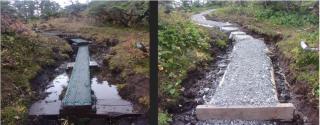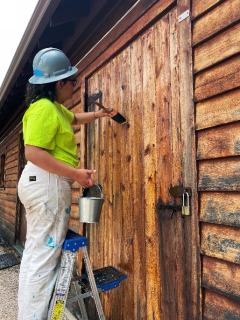Editor’s Note: Today is the second anniversary of the Great American Outdoors Act, which gave the Forest Service new opportunities to deliver benefits to Americans through major investments in recreation infrastructure, public lands access, and land and water conservation. These investments help to improve outdoor recreation and contribute to economic growth and job creation in rural communities.
Every week, Americans relive or create memories as they travel with family and friends to national forests and grasslands. They count on some conveniences, like visitor centers, well-maintained trails, roads, restrooms, campgrounds, bridges and other infrastructure.
For two years. the Forest Service used Great American Outdoor Act investments to augment our work to maintain 370,000 miles of roads, 13,400 bridges, 159,000 miles of trails, 1,700 dams and reservoirs, 1,500 communications sites, 27,000 recreation sites, and 40,000 other facilities. Over time, growing use of these assets coupled with budget constraints strained the system, creating a maintenance backlog as we made difficult decisions on what we could address.
The Great American Outdoors Act, one of several new funding resources, established the National Parks and Public Land Legacy Restoration Fund, creating dedicated funding to address deferred maintenance across the federal land management agencies. For fiscal years 2021-2025, the Forest Service will receive up to $285 million to tackle our backlog in an effort to help visitors feel safer and more easily enjoy their national forests and grasslands. The act also ensured that going forward the Land and Water Conservation Fund, managed by the Departments of Agriculture and the Interior, receives $900 million each year going forward.

While the LWCF program continued building on its long-term success, the Legacy Restoration Fund program was built up from the ground up. So far, the agency has launched more than 880 projects to address more than $570 million in deferred maintenance needs. This includes more than 2,000 recreation sites, such as the Corral Canyon and Bobcat Meadow Off-Highway Vehicles Campgrounds on the Cleveland National Forest in Southern California, Rock Creek Horse Camp on the Bitterroot National Forest in Montana and parts of Idaho, and Doniphan and Poplar Bluff recreation sites on the Mark Twain National Forests in Missouri. The projects also tackle deferred maintenance on nearly 2,000 trails, through projects like the North Fork Trail on the Gifford Pinchot National Forest in Montana, or Trio of Trails on the Tongass National Forest in Alaska.
The benefits of these types of projects extend well beyond recreation. On many of the projects, the Forest Service partners, such as the Youth Corps and Student Conservation Corps, provide crucial skills and work experience for young people throughout the country.
For example, through their work on the Post-Ranch Fire Rehab Snow Mountain Wilderness Trails Project in California, young adults honed their trail maintenance skills while contributing to wilderness conservation. Youth Conservation Corps students worked on the historical Teepee Work Center on the Black Hills National Forest in South Dakota. Those young people developed new construction skills that will benefit their career beyond just this one project.
From recreation to historical preservation and economic developments, the investments into deferred maintenance, and land and water conservation projects, impact rural communities across the entire continent. The Forest Service continues to take full advantage of the opportunities afforded by the Great America Outdoors Act to help make American forests and grasslands more accessible and safer.







